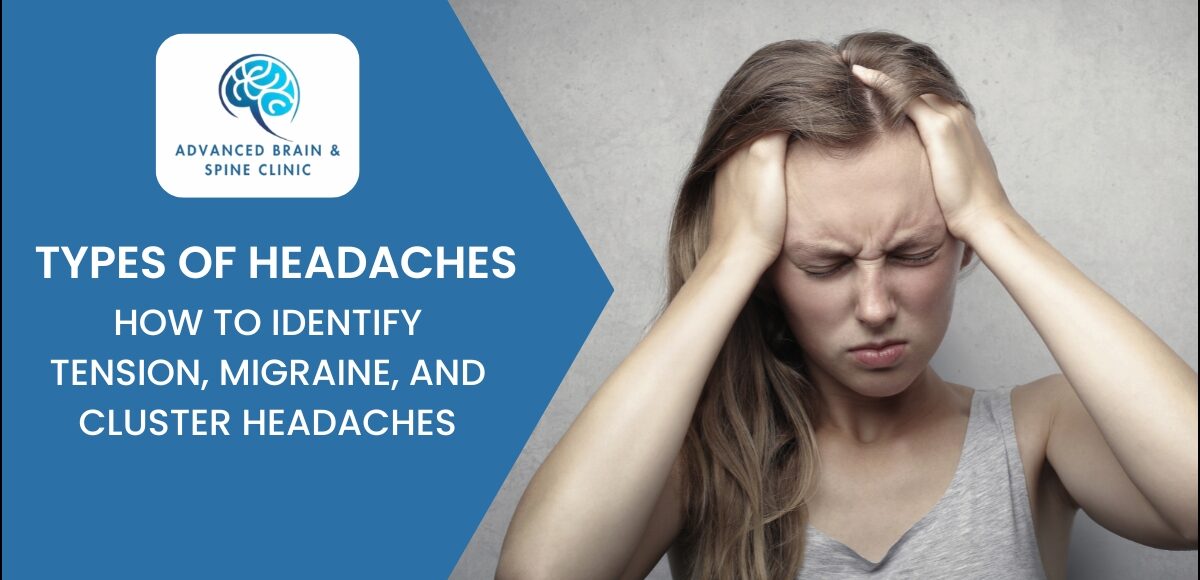
Types of Headaches: How to Identify Tension, Migraine, and Cluster Headaches
We’ve all experienced a headache. That dull, persistent ache that makes it hard to focus. But did you know that not all headaches are the same? Understanding the type of headache you’re experiencing is the first and most crucial step toward finding effective relief.
This guide will help you distinguish between the three most common primary headache disorders: tension, migraine, and cluster headaches.
1. Tension Headache: The Most Common Culprit
Often described as a “band-like” pressure around the forehead or a constant, dull ache on both sides of the head, tension headaches are the most frequent type.
Key Identifiers:
- Pain Type: Mild to moderate, constant pressure or tightness.
- Location: Both sides of the head (bilateral), often the forehead, temples, or back of the head and neck.
- Duration: Can last from 30 minutes to several days.
- Other Symptoms: No nausea or vomiting. Sensitivity to light or sound is uncommon.
- Triggers: Stress, poor posture, anxiety, and lack of sleep.
While uncomfortable, tension headaches rarely stop you from your daily activities.
2. Migraine Headache: More Than Just a Bad Headache
Migraines are a complex neurological condition, often misunderstood as just a “severe headache.” They can be debilitating and significantly impact your quality of life.
Key Identifiers:
- Pain Type: Moderate to severe, throbbing or pulsating pain.
- Location: Often one side of the head (unilateral), but can shift.
- Duration: 4 to 72 hours if untreated.
- Other Symptoms: Nausea, vomiting, and extreme sensitivity to light (photophobia) and sound (phonophobia). Some people experience an “aura” before the pain starts, which can include visual disturbances like flashing lights or blind spots.
- Triggers: Hormonal changes, certain foods, bright lights, strong smells, and changes in weather.
3. Cluster Headache: The Most Severe
Cluster headaches are relatively rare but are considered one of the most painful conditions a person can experience. They occur in cyclical patterns, or “clusters.”
Key Identifiers:
- Pain Type: Excruciating, sharp, burning, or piercing pain, often described as a “hot poker in the eye.”
- Location: Strictly one-sided, focused around or behind one eye.
- Duration: Intense pain peaks quickly, lasting 15 minutes to 3 hours.
- Other Symptoms: Restlessness (inability to sit still), redness or tearing in the eye, drooping eyelid, and nasal congestion on the affected side.
- Pattern: Attacks occur in “clusters,” often at the same time each day, for weeks or months, followed by a remission period.
Why a Correct Diagnosis is Crucial?
Self-treating frequent headaches with over-the-counter painkillers can lead to “medication-overuse headaches,” creating a vicious cycle. A proper diagnosis from a specialist is essential to create a targeted treatment plan that addresses the root cause, not just the symptoms.
If you are struggling to manage recurring headaches, you don’t have to suffer in silence. Accurate diagnosis is the foundation of effective treatment.
Dr. Chetna Patil, a renowned specialist for headache treatment in Wakad and Pimpri Chinchwad, offers comprehensive care. With a focus on identifying the specific type of headache and its underlying triggers, she creates personalized management plans that can include lifestyle modifications, preventive strategies, and advanced treatments to help you reclaim your life from pain.
Frequently Asked Questions (FAQs)
1. What is the main difference between a migraine and a tension headache?
Migraines typically cause throbbing pain on one side with nausea and light sensitivity, while tension headaches feel like a constant band of pressure on both sides without other symptoms.
2. What does a stress headache feel like?
A stress (tension) headache feels like a tight band or constant pressure around your forehead or at the back of your head and neck.
3. When should I be worried about a headache?
Seek immediate medical attention if your headache is sudden and severe (“thunderclap”), is accompanied by fever, confusion, weakness, or follows a head injury.
4. What is the fastest way to relieve a tension headache?
Resting in a quiet room, applying a cold or warm compress to your neck, gentle stretching, and staying hydrated can provide quick relief.
5. Are cluster headaches dangerous?
While intensely painful, cluster headaches themselves are not typically life-threatening, but they require a precise diagnosis and professional treatment to manage the attacks effectively.


